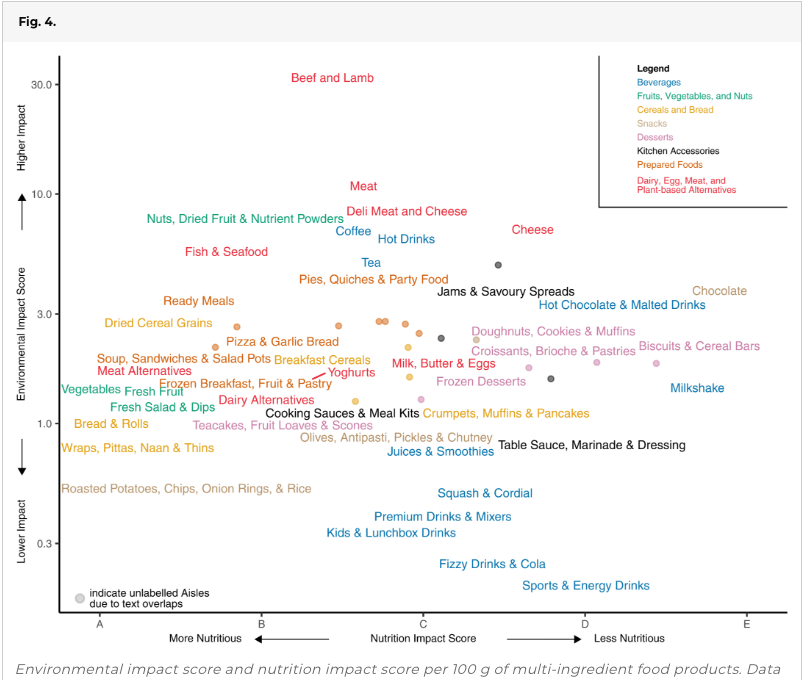Sonia Fernandez, UC Santa Barbara

We’re all capable of slowing down the effects of a warming Earth, and it could be as simple as how we stock our pantries.
An international team of scientists has evaluated the environmental impacts of more than 57,000 food products — the stuff you typically find as you wander the aisles of your local grocery. If this type of information is made easily available to the public, they say, it could not only enable the transition to a more sustainable food system, but chances are it could also improve people’s health.
“The goal is to have a simpler, and more rigorous quantitative way to inform consumers about the tens of thousands of different items they might buy in a grocery store,” said ecologist David Tilman, a professor at UC Santa Barbara’s Bren School of Environmental Science & Management, and also at the University of Minnesota’s College of Biological Sciences. Tilman is a co-author of a study that appears in the Proceedings of the National Academies of Science.
According to the researchers’ assessment, beef and lamb take the greatest toll on the environment, with impacts far outpacing those of other proteins such as chicken, fish and seafood and nuts, which also are on the higher end of the environmental impact scale.
“Many people consider beef to taste good, and I understand why, but it is a very inefficient way to create food for humans,” Tilman said. Meanwhile, processed drinks such as soda and energy drinks were rated at the lowest impact level of food products evaluated, sharing space with plant-based grocery foods such as rice and flatbreads.
A decade of studying food products
While much research has gone into the environmental impacts of food commodities such as fruits, wheat and beef, most food products contain many different ingredients, each of which have taken their own routes to become part of that product. This lifecycle data, which informs the total environmental impacts of producing, harvesting, transporting and processing of said ingredients, are largely invisible to the consumer, as are the proportions of ingredients. According to the study, this information gap exists because “the exact amount of each ingredient and their supply chain in each food product are often considered a trade secret.” The sheer number of food products and their variety makes the assessment a “daunting” task for food companies and for retailers aiming to reduce their carbon emissions.
To overcome these limitations, the researchers, led by first author Michael Clark of Oxford University, used prior knowledge from ingredient lists to infer the composition of each ingredient. They then paired this information with environmental databases to gauge impacts across four indicators: greenhouse gas emissions, land use, water stress and eutrophication potential (the magnitude of excess nutrients from production that can pollute surrounding environment and waterways).
“This is the result of a decade since Mike and I started working on this,” said Tilman, who is Clark’s former advisor. “It started with doing some of the lifecycles ourselves, then using many of these lifecycles that were published. And then we started critically evaluating the quality of lifecycle data available for each of the major food commodities.” They consulted previously published papers, conducted further analyses and used their approach on 57,000 food products found in Tesco supermarkets, a major grocery chain in the United Kingdom and Ireland.
Food graded by environmental and nutritional impact

“You go to a grocery store in Europe and it doesn’t look very different from a grocery store in the United States,” Tilman said. While humans around the world don’t have the exact same taste preferences, he added, we tend to have to similar tastes, which results in more or less the same kind of food products in our stores.
These tastes tend to gravitate to foods that contain high levels of sugar. It’s a commodity that is both cheap and produced in abundance, with effects that have led to increased rates of obesity, diabetes and other conditions related to overconsumption of highly processed foods that often contain high fructose corn syrup.
“That’s what happened with the Green Revolution,” Tilman said of an unintended consequence of the world’s move in the 1950s and ‘60s toward high-yield, industrial farming processes that include pesticides, fertilizers and monocultures. “Sugar is cheap. Fats are cheap and salt is cheap. People love salty, fatty and sweet kinds of foods; that’s what our taste preferences are. They made total sense during our evolutionary past, and now that these foods are so cheap and readily available, we eat them in excess.”
Healthy choices = healthy earth
In a previous study, Tilman and Clark found that in general, diets that included healthy, less-processed foods were also healthier for the environment. “We know there’s a relationship there, and we wanted to apply this for individual foods,” Tilman said. As a result, the researchers’ current study also ranks grocery foods by nutritional impact, with plant-based, less processed foods on the healthier end of the scale for both humans and the environment, and highly processed grains and dairy products toward the less-healthy end.
“The healthiest diets that we know of are variants on the classical Mediterranean diet, which has many servings of fruits and vegetables a day, and whole grains,” Tilman said. “Whole grain has the advantage of having fiber, which helps slow the rate at which starch becomes sugars.” The main meat is fish, he added, with other meats used as flavoring and on special occasions. Other environmentally friendly and nutritious diets include vegetarian and pescatarian diets, provided hydrogenated fats and sugars are kept to a minimum. There isn’t enough scientific data yet to put the vegan diet in the same group, but Tilman suspects it belongs there as well.
Still, more work needs to be done to refine the researchers’ assessment. There’s a lot of variability in the proportion and type of ingredients in similar grocery store foods that can lead to differences in health and environmental impacts, and there are also alternative processes to consider, Tilman said. But the hope is that this information becomes widely available, empowering consumers to make better food choices for the health of both their bodies and the environment.
“I hope this information ends up on packages,” Tilman said. “And I hope because it’s on packages that companies that make different foods will willingly tell us the exact ingredients and amounts in their foods, so we can give the most rigorous, honest evaluation of their product.”

